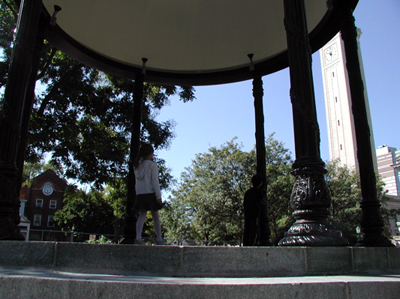Late last year, a widely-reported study (PDF) called "Social Interaction and Urban Sprawl" emerged from the University of California at Irvine’s economics department regarding the impact of sprawl vs. density on social interactions. The department conveniently provides a short video clip of lead author Jan Brueckner speaking about the findings, although largely what he says in the few seconds available is simply that human interaction is good for us.

Touting the potential social benefits of lower density, the study appears to claim that a ten percent decrease in density means that people are ten percent more likely to talk to their neighbors once a week, for example. The study has been quoted right and left, including in the recently-released winter 2007 issue of CommonWealth magazine, in a statistical brief by Robert David Sullivan.
The findings are being disputed by a variety of people as "manipulated" and plain wrong, for example, in a New Urban News piece by editor Robert Steuteville:
[The ten percent finding] contradicts widely cited research by Harvard sociologist Robert Putnam, author of Bowling Alone … [S]ome writers, a few of them with an ax to grind, crowed that the study undercuts arguments in favor of New Urbanism and smart growth. …
The study really found that a 93 percent decline in density results in only a five percent higher chance of talking with neighbors regularly. Rather than a small decrease in density having a significant effect, it takes a 15-fold decline to boost social activity even a little, according to the study.

But even that small effect may be illusory. The survey responses actually show no significant difference in levels of social activity at various densities, with the exception that in higher-density areas people talk to their neighbors and hang out with friends more frequently. That’s right—more frequently, not less.
Readers of recent news articles should be forgiven if they came to the conclusion that people in the suburbs socialize more than city dwellers—a false conclusion. The way this study has been conducted and presented says more about the researchers’ willingness to manipulate data to tease out findings that will generate buzz than it says about social life and density.
Steuteville goes on to say that density’s benefits, as put forth by New Urbanists, aren’t necessarily meant to be merely social, anyway:
Density is a crude measure and it is unlikely that, by itself, this attribute would have much impact on social interaction. New urbanists advocate higher densities, but not to increase socializing—rather because it brings more activities within walking distance.
Perhaps the moral of this story is that we could try introducing ourselves to our neighbors no matter where we live, and our lives would be better off for it. Arguing over whether that’s more easily or frequently accomplished in a dense environment or not is just a method of procrastination. Where there are humans, social interaction is possible.



